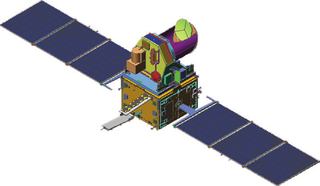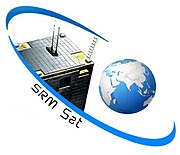The Canadian Advanced Nanospace eXperiment (CanX) program is a Canadian CubeSat nanosatellite program operated by the University of Toronto Institute for Aerospace Studies, Space Flight Laboratory (UTIAS/SFL). The program's objectives are to involve graduate students in the process of spaceflight development, and to provide low-cost access to space for scientific research and the testing of nanoscale devices. The CanX projects include CanX-1, CanX-2, the BRIght Target Explorer (BRITE), and CanX-4&5.

Greenhouse Gases Observing Satellite (GOSAT), also known as Ibuki, is an Earth observation satellite and the world's first satellite dedicated to greenhouse gas monitoring. It measures the densities of carbon dioxide and methane from 56,000 locations on the Earth's atmosphere. The GOSAT was developed by the Japan Aerospace Exploration Agency (JAXA) and launched on 23 January 2009, from the Tanegashima Space Center. Japan's Ministry of the Environment, and the National Institute for Environmental Studies (NIES) use the data to track gases causing the greenhouse effect, and share the data with NASA and other international scientific organizations.

Megha-Tropiques was a satellite mission to study the water cycle in the tropical atmosphere in the context of climate change. A collaborative effort between Indian Space Research Organisation (ISRO) and French Centre National d’Etudes Spatiales (CNES), Megha-Tropiques was successfully deployed into orbit by a PSLV rocket in October 2011.
STUDSAT, is a CubeSat satellite designed by students. This project was conceptualised and project managed by undergraduate students across India. STUDSAT is a picosatellite successfully launched on 12 July 2010 from Satish Dhawan Space Centre into a Sun-synchronous orbit. The mission's objective was for students to have a hands-on experience with the design, fabrication and realisation of a space mission at a minimum cost. Experimental in nature, the mission life was stated to be six months.
ITUpSAT1, short for Istanbul Technical University picoSatellite-1, is a single CubeSat built by the Faculty of Aeronautics and Astronautics at the Istanbul Technical University. It was launched on 23 September 2009 atop a PSLV-C14 satellite launch vehicle from Satish Dhawan Space Centre, Sriharikota, Andhra Pradesh in India, and became the first Turkish university satellite to orbit the Earth. It was expected to have a minimum of six-month life term, but it is still functioning for over two years. It is a picosatellite with side lengths of 10 centimetres (3.9 in) and a mass of 0.990 kilograms (2.18 lb).
Jugnu, is an Indian technology demonstration and remote sensing CubeSat satellite which was operated by the Indian Institute of Technology Kanpur. Built under the guidance of Dr. N. S. Vyas, it is a nanosatellite which will be used to provide data for agriculture and disaster monitoring. It is a 3-kilogram (6.6 lb) spacecraft, which measures 34 centimetres (13 in) in length by 10 centimetres (3.9 in) in height and width. Its development programme cost around 25 million rupee. It has a design life of one year.

This article documents notable spaceflight events during the year 2019.

This article documents notable spaceflight events during the year 2018. For the first time since 1990, more than 100 orbital launches were performed globally.

RAX-2 is a CubeSat satellite built as a collaboration between SRI International and students at the University of Michigan College of Engineering. It is the second spacecraft in the RAX mission. The RAX-1 mission ended after approximately two months of operation due to a gradual degradation of the solar panels that ultimately resulted in a loss of power. RAX team members applied the lessons learned from RAX-1 to the design of a second flight unit, RAX-2, which performs the same mission concept of RAX-1 with improved bus performance and additional operational modes. Science measurements are enhanced through interactive experiments with high power ionospheric heaters where FAI will be generated on demand.
VesselSat-1 was a miniaturized satellite built and owned by LuxSpace, which was operated by Orbcomm under lease. VesselSat-1 and its sister satellite, VesselSat-2 were used by Orbcomm to compensate the functionality of the malfunctioning Orbcomm-QL satellites.
TUGSAT-1, also known as BRITE-Austria and CanX-3B, is the first Austrian satellite. It is an optical astronomy spacecraft operated by the Graz University of Technology as part of the international BRIght-star Target Explorer programme.
CUTE-1.7 + APD II, or CUTE-1.7 + APD 2, is a Japanese nanosatellite which was launched in 2008 as a follow-up to the CUTE-1.7 + APD satellite. It was built and is operated by the Tokyo Institute of Technology.
IRNSS-1D is a satellite in the Indian Regional Navigational Satellite System (IRNSS) constellation. The satellite is the fourth of seven in the constellation, launched after IRNSS-1A, IRNSS-1B and IRNSS-1C. The satellite is the only satellite in the constellation slated to provide navigational services to the region. The satellite will be placed in geosynchronous orbit. It was launched successfully on 28 March 2015 onboard ISRO's PSLV-C27 from Satish Dhawan Space Centre, Sriharikota.

Dhruva Space Private Limited is an Indian private aerospace manufacturer headquartered in Hyderabad, Telangana. Founded in 2012 by Sanjay Srikanth Nekkanti, the company is engaged in the development of small satellites in the commercial, governmental and academic markets. It provides full-stack space-engineering solutions across launch, space and ground segments – namely, the building, launching and operation of satellites.
ScatSat-1 was a satellite providing weather forecasting, cyclone prediction, and tracking services to India. It has been developed by ISRO Satellite Centre, Bangalore whereas its payload was developed by Space Applications Centre, Ahmedabad. The satellite carries a Ku-band scatterometer similar to the Oceansat-2 which became dysfunctional after its life span of four-and-a-half years. India was dependent on NASA's ISS-RapidScat for prediction of cyclone forecasting and weather prediction. The data generated by this mini-satellite are used by National Aeronautics and Space Administration (NASA), European Organisation for the Exploitation of Meteorological Satellites (EUMETSAT) and National Oceanic and Atmospheric Administration (NOAA).
PSLV-C28 was the 29th consecutive successful mission of the PSLV program. The PSLV-C28 carried and successfully deployed 5 satellites in the Sun-synchronous orbit. With a launch mass of 320,000 kilograms (710,000 lb) and payload mass of payload mass 1,440 kilograms (3,170 lb), the C28 was the heaviest commercial mission undertaken by the Indian Space Research Organisation and Antrix Corporation. The PSLV-C28 carried three identical optical Earth observation satellites, an optical Earth observation technology demonstrator microsatellite (CBNT-1), and an experimental nanosatellite (De-orbitSail). All the satellites were built by Surrey Satellite Technology (SSTL). Although built by SSTL, the "De-orbitSail" belonged to the Surrey Space Centre.
SathyabamaSat is a micro experimental satellite developed by students and faculty of Sathyabama University, Chennai to collect data on greenhouse gases. It was launched along with the Cartosat-2C satellite atop PSLV-C34. It was launched June 22, 2016.

PSLV-C37 was the 39th mission of the Indian Polar Satellite Launch Vehicle (PSLV) program and its 16th mission in the XL configuration undertaken by the Indian Space Research Organisation (ISRO). Launched on 15 February 2017 from the Satish Dhawan Space Centre at Sriharikota, Andhra Pradesh, the rocket successfully carried and deployed a record number of 104 satellites in Sun-synchronous orbits in a single mission, breaking the earlier record of launching 37 satellites by a Russian Dnepr rocket on 19 June 2014. This record was held until the launch of the Transporter-1 mission by SpaceX on 24 January 2021 which launched 143 satellites.








